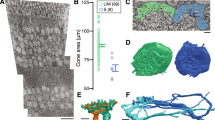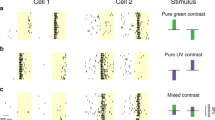Abstract
VISUAL information is conveyed to the brain by retinal ganglion cells. Midget ganglion cells serve fine spatial vision1,2 by summing excitation from a receptive field 'centre', receiving input from a single cone in the central retina, with lateral inhibition from a receptive field 'surround', receiving input from many surrounding cones. Midget ganglion cells are also thought to serve colour opponent vision1–6 because the centre excitation is from a cone of one spectral type, while the surround inhibition is from cones of the other type4,6. The two major cone types, middle (M)- and long-(L)wavelength sensitive, are equally numerous and randomly distributed in the primate central retina7–9, so a spectrally homogeneous surround requires that the cells mediating lateral interactions (horizontal or amacrine cells) receive selective input from only one cone type. Horizontal cells cannot do this because they receive input indiscriminately from M and L cones10–12. Here we report that the amacrine cells connected to midget ganglion cells are similarly indiscriminate. The absence of spectral specificity in the inhibitory wiring raises doubt about the involvement of midget ganglion cells in colour vision and suggests that colour opponency may instead be conveyed by a different type of ganglion cell.
This is a preview of subscription content, access via your institution
Access options
Subscribe to this journal
Receive 51 print issues and online access
$199.00 per year
only $3.90 per issue
Buy this article
- Purchase on Springer Link
- Instant access to full article PDF
Prices may be subject to local taxes which are calculated during checkout
Similar content being viewed by others
References
Merigan, W. H., Katz, L. M. & Maunsell, J. H. R. J. Neurosci. 11, 994–1001 (1991).
Schiller, P. H., Logothetis, N. K. & Charles, E. R. Nature 343, 68–70 (1990).
Derrington, A. M., Krauskopf, J. & Lennie, P. J. Physiol., Lond. 357, 241–265 (1984).
Reid, R. C. & Shapley, R. M. Nature 356, 716–718 (1992).
Kolb, H. & Dekorver, L. J. comp. Neurol. 303, 617–636 (1991).
Lee, B. B. Vision Res. 36, 631–644 (1996) .
Mollon, J. D. & Bowmaker, J. K. Nature 360, 677–679 (1992).
Calkins, D. J., Schein, S. J., Tsukamoto, Y. & Sterling, P. Nature 371, 70–72 (1994).
Packer, O. S., Williams, D. R. & Bensinger, D. G. J. Neurosci. 16, 2251–2260 (1996).
Boycott, B. B., Hopkins, J. M. & Sperling, H. G. Proc. R. Soc. Lond. B 229, 345–379 (1987).
Wässle, H., Boycott, B. B. & Röhrenbeck, J. Eur. J. Neurosci. 1, 421–435 (1989).
Dacey, D. M., Lee, B. B., Stafford, D. K., Pokorny, J. & Smith, V. C. Science 271, 656–659 (1996).
Dowling, J. E. & Boycott, B. B. Proc. R. Soc. Lond. B 166, 80–111 (1966).
Boycott, B. B. & Wässle, H. Eur. J. Neurosci. 3, 1069–1088 (1991).
Klug, K., Tsukamoto, Y., Sterling, P. & Schein, S. J. Soc. Neurosci. Abstr. 18, 352.5 (1992).
Klug, K., Tsukamoto, Y., Sterling, P. & Schein, S. J. Invest. Ophthalmol. vis. Sci. (suppl.) 34, 1398 (1993).
Wiesel, T. N. & Hubel, D. H. J. Neurophysiol. 29, 1115–1156 (1966).
Derrington, A. M. & Lennie, P. J. Physiol., Lond. 357, 219–240 (1984).
Zrenner, E. Neurophysiological Aspects of Color Vision in Primates (Springer, Berlin, 1983).
Kaplan, E., Lee, B. B. & Shapley, R. M. in Prog. Retin. Res. 9, 273–336 (1990).
Lennie, P., Haake, P. W. & Williams, D. R. in Computational Models of Visual Processing (eds Landy, M. S. & Movshon, J. A.) 71–82 (MIT Press, Cambridge, MA, 1991).
Rodieck, R. W. in From Pigments to Perception (eds Valberg, A. & Lee, B. B.) 83–93 (Plenum, New York, 1991).
Tsukamoto, Y., Masarachia, P., Schein, S. J. & Sterling, P. Vision Res. 32, 1809–1815 (1992).
DeMonasterio, F. M. J. Neurophysiol. 41, 1418–1434 (1978).
Croner, L. J. & Kaplan, E. Vision Res. 35, 7–24 (1995).
Grünert, U. & Wässle, H. J. comp. Neurol. 297, 509–524 (1990).
Vardi, N. & Sterling, P. Vision Res. 34, 1235–1246 (1994).
Vardi, N., Kaufman, D. L. & Sterling, P. Vis. Neurosci. 11, 135–142 (1994).
Author information
Authors and Affiliations
Rights and permissions
About this article
Cite this article
Calkins, D., Sterling, P. Absence of spectrally specific lateral inputs to midget ganglion cells in primate retina. Nature 381, 613–615 (1996). https://doi.org/10.1038/381613a0
Received:
Accepted:
Issue Date:
DOI: https://doi.org/10.1038/381613a0
This article is cited by
-
Evolution of the circuitry for conscious color vision in primates
Eye (2017)
-
A color-coding amacrine cell may provide a blue-Off signal in a mammalian retina
Nature Neuroscience (2012)
-
Noise correlations improve response fidelity and stimulus encoding
Nature (2010)
-
The machinery of colour vision
Nature Reviews Neuroscience (2007)
-
Colour tuning in human visual cortex measured with functional magnetic resonance imaging
Nature (1997)
Comments
By submitting a comment you agree to abide by our Terms and Community Guidelines. If you find something abusive or that does not comply with our terms or guidelines please flag it as inappropriate.



